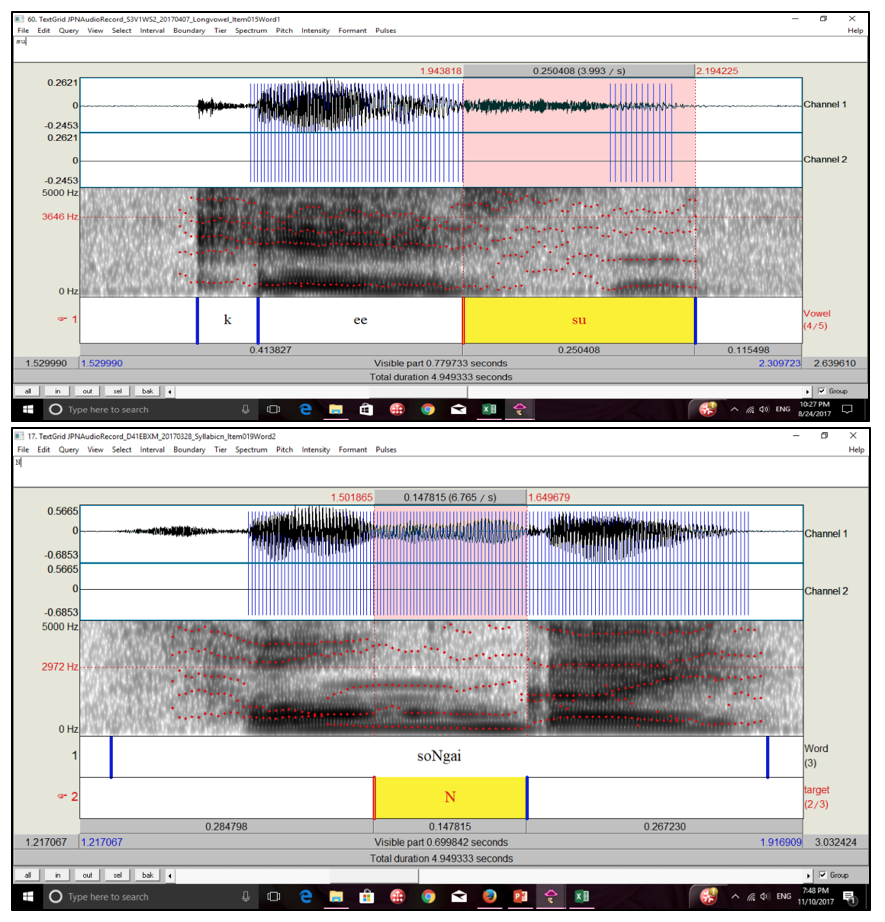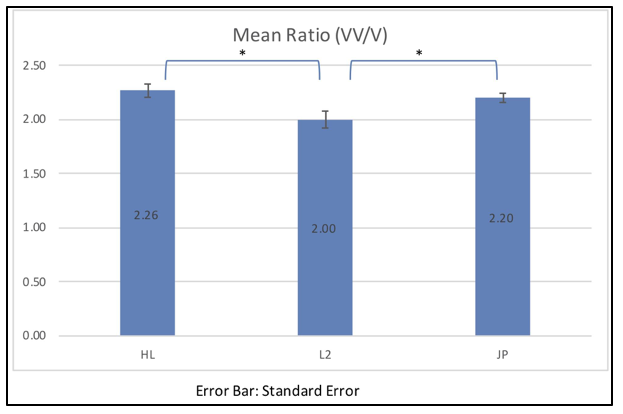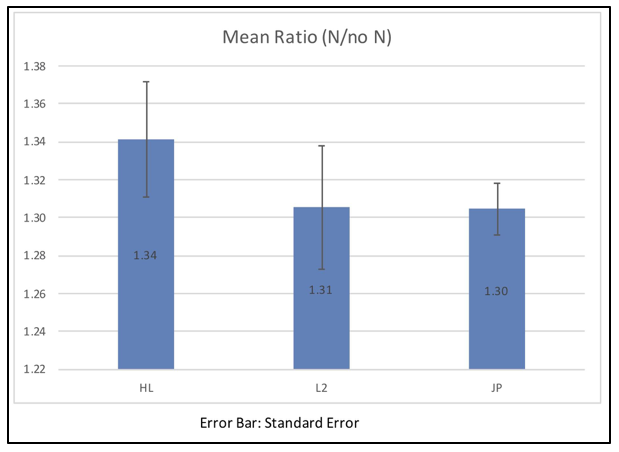Contents
- Tomonori Nagano (LaGuardia Community College, CUNY), Mieko Sperbeck (John Jay College, CUNY), Ai Mizoguchi (CUNY Graduate Center), & Jun Choi (LaGuardia Community College, CUNY)
- Research Questions
- Heritage Language Speakers (Polinsky & Kagan, 2007)
- Previous Studies
- Vowel length and the length of moraic nasal
- Long-distance binding of reflective pronoun 自分 (jibun) (Kuno, 1976)
- Manner-of-motion vs. Inherently directed motion verbs + PP (Inagaki, 2001, 2002)
- JLPT Vocabulary Items (max 80 points) / Proficiency level
- Vowel length contrast (V vs. VV)
- Nasal Contrast
- Results of the long-distance jibun
- Results of the Motion Verbs + PP (on the scale of 1-7; SD in parentheses)
Tomonori Nagano (LaGuardia Community College, CUNY), Mieko Sperbeck (John Jay College, CUNY), Ai Mizoguchi (CUNY Graduate Center), & Jun Choi (LaGuardia Community College, CUNY)
Abstract
This ongoing experimental study examined whether or not heritage language (HL) learners of Japanese have significant advantages over second language (L2) learners of Japanese on phonological tasks as well as syntactic (grammar) tasks. Previous studies have found that HL learners benefit from a significant advantage in phonological knowledge over L2 learners but are on par with L2 learners in syntactic (grammar) knowledge. In our experiment, a total of 24 native speakers of Japanese, HL speakers of Japanese, and Japanese L2 learners were recruited and tested with two phonological tasks and two syntactic tasks.
Research Questions
- Do Japanese heritage language learners have a learning advantage in phonological knowledge but not in syntactic knowledge?
- If so, what are the pedagogical implications of this imbalance?
Background
Heritage Language Speakers (Polinsky & Kagan, 2007)
- HL speakers/learners are bilingual speakers who have acquired their minority (non-English) languages at home
- HL speakers/learners have undergone the shift of their primary language from the home language to English due to social Anglophone pressure such as K-12 schooling
- “[A] language student who is raised in a home where a non-English language is spoken” and “speaks or at least understands the language (…) and is to some degree bilingual in that language and in English” (Valdés, 2001, p. 38).”
Previous Studies
- Au et al. (2002), Knightly et al. (2003), and Oh et al. (2003)
- Korean and Spanish low-proficiency HL speakers had better phonological perception and production (in terms of voice onset time or VOT) than L2 speakers at the same proficiency
- Other studies also found phonological advantages among HL speakers
- Au et al. (2002) and Knightly et al. (2003) begin{itemize
- Korean and Spanish low-proficiency HL speakers did not perform better than L2 speakers in the morphosyntax task (e.g., gender agreement among determiners, adjectives, and nouns in Spanish)
- Other studies also found no syntactic advantage among HL speakers, but the results are quite mixed.
Experiment Design
- The experiment was designed with PsychoPy (Peirce, 2012), a Python-based psychology experiment program. Audio recordings were analyzed with Praat (Boersma & Weenink, 2001).
- The experiment consists of: vspace{-0.02in begin{itemize
- Language background questionnaire (5 min)
- Japanese vocabulary test (70 JLPT vocabulary items / 10-15 min)
- Pronunciation elicitation task (30-45 min)
- Grammatical judgment task (30-45 min)
- All research participants received $25 honorarium for their participation.
- The participant recruitment is still continuing. As of today, we have tested
- 11 native Japanese speakers
- 6 HL Japanese speakers
- 7 L2 Japanese speakers

Tasks
Vowel length and the length of moraic nasal
- Participants were asked to produce the target word in a career sentence: さっき X と言 (い)った。
- The target words (x) are minimal pairs of: begin{itemize
- Vowel length (e.g., おじいさん /oji:san/ vs. おじさん /ojisan/)
- Moraic nasal (e.g., あんまり /aNmari/ vs. あまり /amari/ )
- Praat was used to measure the durations of the following segments: begin{itemize
- Vowel length, length of moraic nasal, and the whole word

Long-distance binding of reflective pronoun 自分 (jibun) (Kuno, 1976)
- In Japanese, the antecedent of 自分 (じぶん) (jibun) can be in the matrix clause of the compound sentence (long-distance)
- John says that Mary will take good care of herself/*himself. (self = Mary, not John)
- ジョンは、メアリーが自分 (じぶん)を大事 (だいじ)にすると言 (い)った (自分 (じぶん) = John or Mary)
- The dative phrase (adjunct) cannot be the antecedent of jibun
- ジョンは、メアリーに自分 (じぶん)を大事 (だいじ)にすると言 (い)った (自分 (じぶん) = John)
Manner-of-motion vs. Inherently directed motion verbs + PP (Inagaki, 2001, 2002)
- Manner-of-motion verb takes locational particle で whereas inherently-directed motion verb takes directional particle に. begin{itemize
- [mannerV + locational PP]: ビルは、公園 (こうえん)で歩 (ある)いた。
- [mannerV + directional PP] (questionable): superscript{?ビルは、公園 (こうえん)に歩 (ある)いた。
- [inherently-directedV + directional PP]: ビルは、公園 (こうえん)に行 (い)った。

Results
JLPT Vocabulary Items (max 80 points) / Proficiency level
- Most heritage participants were intermediate-advanced proficiency whereas L2 participants were low-intermediate proficiency.
- Proficiency is not matched; More high-intermediate L2 participants needed.
 Vowel length contrast (V vs. VV)
Vowel length contrast (V vs. VV)
- The duration ratios of long to short vowels are similar between native and heritage speakers.
- L2 speakers’ duration ratios of long to short vowels are significantly smaller than those of Japanese and heritage speakers.

Nasal Contrast
- The duration ratios of words with /N/ to those without /N/ are similar between native and L2 speakers.
- However, L2 speakers made numerous pronunciation errors compared to heritage speakers (28% errors vs. 4% errors).

Results of the long-distance jibun

Results of the Motion Verbs + PP (on the scale of 1-7; SD in parentheses)

Conclusions
- The data at hand show somewhat more complex pattern than the phonology-vs-(morpho)syntax dichotomy. begin{itemize
- Heritage advantage in: begin{itemize
- Phonological: Vowel contrast (V vs. VV)
- Syntactic: Long-distance reflexive pronoun
- No heritage advantage in begin{itemize
- Phonological: Nasal /N/ contrast
- Syntactic: P (-ni or -de) + Motion verbs
- Statistical analysis with a larger sample (esp. advanced L2) is necessary.
- Heritage advantage in: begin{itemize
Pedagogical Implications
- The results of production tasks have shown that Japanese HL learners have advantage in producing short vs. long vowel contrast but not in nasal /N/ contrast. What this means is that both HL and L2 learners of Japanese will benefit if provided with the instruction that will focus on improving oral production skills of /N/. It may be useful to explicitly show how Japanese /N/ is produced depending on the immediately following consonant. /N/ is realized as a uvular nasal when it’s placed either word- or sentence-finally. Otherwise, /N/ is known as having allophones depending on the following phoneme; [m] when followed by bilabials, [ŋ] when followed by velars, and [n] when followed by alveolars (Vance 2008). L2 learners of Japanese will also benefit from additional instructions to develop a sense of sub-syllabic unit ‘mora’ as a basic unit of sound. For instance, classroom activities such as mora-counting activity and perceptual discrimination activity might be beneficial. In the former, an instructor asks students to count how many mora(e) a word contains (e.g., ‘ぶんがく /buNgaku/’ as 4 morae and ‘ぶがく/bugaku/’ as 3 morae). In the latter task, students will be asked to identify whether two words that they were presented auditory are the same or different (e.g., ‘ゆき ゆうき/yuki – yuuki/’ as different).
Please cite as: ”Phonological Advantages of Heritage Learners of Japanese”, (2018) New York, NY: Tomonori Nagano (LaGuardia Community College, CUNY), Mieko Sperbeck (John Jay College, CUNY), Ai Mizoguchi (CUNY Graduate Center), & Jun Choi (LaGuardia Community College, CUNY). Retrieved from: https://iletc.commons.gc.cuny.edu/reshaping-language-interpreting-pedagogy
Materials developed with financial support from ILETC.



